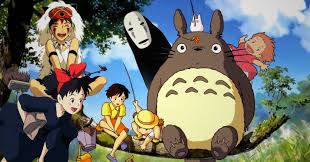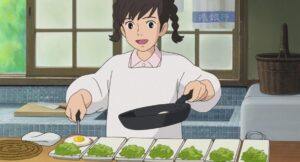Browse in the Library:
Search Posts by Categories:
The One-Way Interstellar Exile [ A Jazz tribute to Studio Ghibli, スタジオジブリのジャズメドレー]
A trip with Chihiro and Kaonashi to destination of nowhere … A Jazz tribute to Studio Ghibli
——————————————————————- Medley List
[00:00] いのちの名前 (千と千尋の神隠し) / Name of Life (Spirited Away) [03:31] 人生のメリーゴーランド (ハウルの動く城) / Merry-Go-Round of Life (Howl’s Moving Castle) [07:19] マルコとジーナのテーマ (紅の豚) / The Theme of Marco and Gina (Porco Rosso) [10:45] 海の見える街 (魔女の宅急便) / A Town with an Ocean View (Kiki’s Delivery Service) [13:35] 風の谷のナウシカ (風の谷のナウシカ) / Nausicaa of the Valley of the Wind
[17:01] やさしさに包まれたなら (魔女の宅急便) / Wrapped in Gentleness (Kiki’s Delivery Service) [20:21] 君をのせて (天空の城ラピュタ) / Carrying You (Castle in the Sky) [24:19] 風の通り道 (となりのトトロ) / The Path of the Wind (My neighbour Totoro) [29:31] 愛は花、君はその種子 (おもひでぽろぽろ) / Love is a Flower, You are the Seed (Only Yesterday) [33:36] いつも何度でも (千と千尋の神隠し) / Always with me (Spirited Away)
Studio Ghibli Inc.
Studio Ghibli Inc. (Japanese: 株式会社スタジオジブリ, Hepburn: Kabushiki-gaisha Sutajio Jiburi) is a Japanese animation film studio headquartered in Koganei, Tokyo. The studio is best known for its animated feature films, and has also produced several short films, television commercials, and one television film.
It was founded on 15 June 1985 by directors Hayao Miyazaki and Isao Takahata and producer Toshio Suzuki, after the success of Topcraft‘s anime film Nausicaä of the Valley of the Wind (1984). Studio Ghibli has also collaborated with video game studios on the visual development of several video games.
Six of Studio Ghibli’s films are among the 10 highest-grossing anime films made in Japan, with Spirited Away (2001) being the second highest, grossing over US$360 million worldwide. Many of their works have won the Animage Anime Grand Prix award, and four have won the Japan Academy Prize for Animation of the Year. Five of Studio Ghibli’s films have received Academy Award nominations. Spirited Away won the Golden Bear in 2002 and the Academy Award for Best Animated Feature Film in 2003. Totoro, a character from My Neighbor Totoro, is the studio’s mascot.
On 3 August 2014, Studio Ghibli temporarily halted production following the retirement of Miyazaki. In February 2017, Toshio Suzuki announced that Miyazaki had come out of retirement again to direct a new feature film, How Do You Live?, with Studio Ghibli.

The name Studio Ghibli was given by Hayao Miyazaki from the Italian noun ghibli, based on the Libyan-Arabic name for the hot desert wind of that country, the idea being the studio would “blow a new wind through the anime industry”. It also refers to an Italian aircraft, the Caproni Ca.309 Ghibli. Although the Italian word is more accurately transliterated as ギブリ (Giburi), the Japanese name of the studio is ジブリ (Jiburi).
Founded on June 15, 1985, the studio is headed by the directors Hayao Miyazaki and Isao Takahata and the producer Toshio Suzuki. Prior to the formation of the studio, Miyazaki and Takahata had already had long careers in Japanese film and television animation and had worked together on The Great Adventure of Horus, Prince of the Sun in 1968 and the Panda! Go, Panda! films in 1972 and 1973, and in 1978, Suzuki became an editor at Tokuma Shoten‘s Animage manga magazine, where the first film he chose was Horus.
A year after his phone call with Takahata and his first encounter with Miyazaki, both about Horus, he made a phone call about the first film Miyazaki ever directed: The Castle of Cagliostro.
The studio was founded after the success of the 1984 film Nausicaä of the Valley of the Wind, written and directed by Miyazaki for Topcraft and distributed by Toei Company.
The origins of the film lie in the first two volumes of a serialized manga written by Miyazaki for publication in Animage as a way of generating interest in an anime version. Suzuki was part of the production team on the film and founded Studio Ghibli with Miyazaki, who also invited Takahata to join the new studio.
The studio has mainly produced films by Miyazaki, with the second most prolific director being Takahata (most notably with Grave of the Fireflies). Other directors who have worked with Studio Ghibli include Yoshifumi Kondō, Hiroyuki Morita, Gorō Miyazaki, and Hiromasa Yonebayashi. Composer Joe Hisaishi has provided the soundtracks for most of Miyazaki’s Studio Ghibli films.
In their book Anime Classics Zettai!, Brian Camp and Julie Davis made note of Michiyo Yasuda as “a mainstay of Studio Ghibli’s extraordinary design and production team”. At one time the studio was based in Kichijōji, Musashino, Tokyo.
In August 1996, The Walt Disney Company and Tokuma Shoten formed a partnership in which Buena Vista Pictures would be the sole international distributor for Tokuma Shoten’s Studio Ghibli animated films. Since then, all three aforementioned films by Miyazaki at Studio Ghibli that were previously dubbed by Streamline Pictures have been re-dubbed by Disney. On June 1, 1997, Tokuma Shoten Publishing consolidated its media operations by merging Studio Ghibli, Tokuma Shoten Intermedia software and Tokuma International under one location.
Over the years, there has been a close relationship between Studio Ghibli and the magazine Animage, which regularly runs exclusive articles on the studio and its members in a section titled “Ghibli Notes.” Artwork from Ghibli’s films and other works are frequently featured on the cover of the magazine. Saeko Himuro‘s novel Umi ga Kikoeru was serialised in the magazine and subsequently adapted into Ocean Waves, Studio Ghibli’s only animated feature-length film created for television and it was directed by Tomomi Mochizuki.
In October 2001, the Ghibli Museum opened in Mitaka, Tokyo. It contains exhibits based on Studio Ghibli films and shows animations, including a number of short Studio Ghibli films not available elsewhere.
The studio is also known for its strict “no-edits” policy in licensing their films abroad due to Nausicaä of the Valley of Wind being heavily edited for the film’s release in the United States as Warriors of the Wind. The “no cuts” policy was highlighted when Miramax co-chairman Harvey Weinstein suggested editing Princess Mononoke to make it more marketable. A Studio Ghibli producer is rumoured to have sent an authentic Japanese sword with a simple message: “No cuts”.
Between 1999 and 2005, Studio Ghibli was a subsidiary brand of Tokuma Shoten; however, that partnership ended on April 2005, when Studio Ghibli was spun off from Tokuma Shoten and was re-established as an independent company with relocated headquarters.
On February 1, 2008, Toshio Suzuki stepped down from the position of Studio Ghibli president, which he had held since 2005, and Koji Hoshino (former president of Walt Disney Japan) took over. Suzuki said he wanted to improve films with his own hands as a producer, rather than demanding this from his employees. Suzuki decided to hand over the presidency to Hoshino because Hoshino has helped Studio Ghibli to sell its videos since 1996 and has also aided the release of the Princess Mononoke film in the United States. Suzuki still serves on the company’s board of directors.
Two Studio Ghibli short films created for the Ghibli Museum were shown at the Carnegie Hall Citywise Japan NYC Festival: “House Hunting” and “Mon Mon the Water Spider” were screened on March 26, 2011.
Takahata developed a project for release after Gorō Miyazaki’s (director of Tales from Earthsea and Hayao’s son) The Tale of the Princess Kaguya – an adaptation of The Tale of the Bamboo Cutter. The last film Hayao Miyazaki directed before retiring from feature films was The Wind Rises which is about the Mitsubishi A6M Zero and its founder.
On Sunday, September 1, 2013, Hayao Miyazaki held a press conference in Venice to confirm his retirement, saying: “I know I’ve said I would retire many times in the past. Many of you must think, ‘Once again.’ But this time I am quite serious.”
On January 31, 2014, it was announced that Gorō Miyazaki will direct his first anime television series, Sanzoku no Musume Rōnya, an adaptation of Astrid Lindgren‘s Ronia the Robber’s Daughter for NHK. The series is computer-animated, produced by Polygon Pictures, and co-produced by Studio Ghibli.
In March 2014, Toshio Suzuki retired as producer and assumed the new position of general manager. Yoshiaki Nishimura replaced Suzuki in the producer role.
On August 3, 2014, Toshio Suzuki announced that Studio Ghibli would take a “brief pause” to re-evaluate and restructure in the wake of Miyazaki’s retirement. He stated some concerns about where the company would go in the future. This led to speculation that Studio Ghibli will never produce another feature film again.
On November 7, 2014, Miyazaki stated, “That was not my intention, though. All I did was announce that I would be retiring and not making any more features.” Lead producer Yoshiaki Nishimura among several other staffers from Ghibli, such as director Hiromasa Yonebayashi, left to found Studio Ponoc in April 2015, working on the film Mary and the Witch’s Flower.
The 2016 animated fantasy film The Red Turtle, directed and co-written by Dutch-British animator Michaël Dudok de Wit in his feature film debut, was a co-production between Studio Ghibli and Wild Bunch.
In February 2017, Toshio Suzuki announced that Hayao Miyazaki has come out of retirement to direct a new feature film with Studio Ghibli.
On November 28, 2017, Koji Hoshino stepped down as President; he was replaced by Kiyofumi Nakajima (former Ghibli Museum director). Hoshino was then appointed as Chairman of Studio Ghibli.
In May 2020, Toshio Suzuki confirmed that a new film from Gorō Miyazaki is in development at Studio Ghibli. On June 3, 2020, Studio Ghibli announced that the film would be an adaptation of the novel Earwig and the Witch by Diana Wynne Jones. The film was announced as the first full 3D CG animated Ghibli film and slated for a television premiere on NHK in late 2020.

